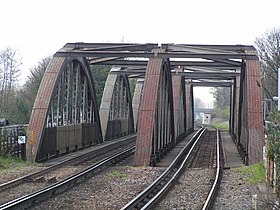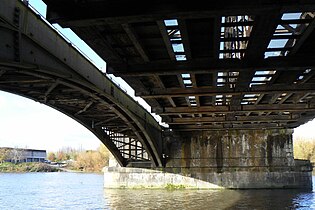Barnes Railway Bridge
Barnes Railway Bridge | |
|---|---|
 The current bridge showing the Locke span | |
| Coordinates | 51°28′22″N 0°15′14″W / 51.4728°N 0.2539°W |
| Carries | Railway Pedestrians |
| Crosses | River Thames |
| Locale | London, England |
| Maintained by | Network Rail |
| Heritage status | Grade II listed structure |
| Preceded by | Chiswick Bridge |
| Followed by | Hammersmith Bridge |
| Characteristics | |
| Design | Truss arch bridge |
| History | |
| Opened | 1895 |
| Location | |
 | |
Barnes Railway Bridge is a Grade II listed railway bridge in the London Borough of Richmond upon Thames and the London Borough of Hounslow.[1][2] It crosses the River Thames in London in a northwest to southeast direction at Barnes. It carries the South Western Railway's Hounslow Loop Line, and lies between Barnes Bridge and Chiswick stations. It can also be crossed on foot, and is one of only three bridges in London to combine pedestrian and rail use; the others being Hungerford Bridge and Golden Jubilee Bridges and Fulham Railway Bridge.
The original bridge at this location was constructed during the late 1849 in accordance with a design produced by the civil engineer Joseph Locke; this structure, which consisted of two pairs of cast iron arch spans, bore a considerable resemblance to the original Richmond Railway Bridge, which was also designed by Locke. On 22 August 1849, the Barnes Bridge was opened to rail traffic. While Locke's incarnation of Barnes Bridge provided relatively trouble-free service, it has not seen use since the 1890s. During the latter decade of the nineteenth century, there was a scare regarding the suitability of cast iron bridges following the collapse of one such structure. As such, it was decided that a successor to the original Barnes Bridge should be constructed.
During the 1890s, a wider replacement bridge, which was designed by Edward Andrews, was constructed by Head Wrightson on behalf of the London & South Western Railway. This structure, which was built directly alongside its predecessor, comprises three spans of wrought iron bow string girders, which carries a pair of railway tracks across the river. A pedestrian walkway was also added to the bridge at this time. Presently,[when?] the original Locke span remains standing along the up-stream side of its replacement, but is not used by any traffic. During 1983, Barnes Bridge was given protection as a Grade II listed structure.[3] In the 2010s, the Barnes Bridge has been temporarily closed to pedestrians during the annual Oxford and Cambridge Boat Race to avoid excessive crowding on the structure.
History
Construction
During the 1840s, the London and Southampton Railway Company, which was later renamed to the London and South Western Railway Company, embarked upon the development of a new railway line, which ran between Nine Elms and Richmond.[4] A few years later, it was decided that this line should be extended through to Windsor; the new extension included the addition of loop from the village of Barnes to Chiswick and Hounslow, which necessitated the construction of what would become known as Barnes Bridge over the River Thames. Prior to the building of this structure, Barnes, which was a small settlement at that time, had never featured a river crossing.[4]
The responsibility for designing this crossing was assigned to the noted civil engineer Joseph Locke, who also designed several other structures along the route, including the similar Richmond Railway Bridge.[1][4] In order to achieve the required statutory height of the bridge above the high water mark of the Thames, as to prevent the structure impinging upon the passage of traditional river traffic, Locke determined that it would be necessary to embank the river. Furthermore, in order to accommodate the bridge's construction along the south side of the river, several properties within ‘’The Terrace’’, a street of modest Georgian houses, had to be demolished to provide sufficient clearance, as the structure and connecting lines pass directly through the estate.[4]
As designed by Locke, Barnes Bridge consisted of two pairs of cast iron arch spans, which had a length of 36.57 meters and a rise of 3.66 meters.[4] Each arch was cast in four individual sections, while each span was strengthened via six cast iron arch ribs, which had a depth of 915mm. These spans were supported on brick piers, which were faced in Bramley Fall stone, and carried a deck composed of timber across the river.[4] During 1846, Fox Henderson & Co were appointed as the contractor for building the structure; work on its construction commenced shortly thereafter. The completed bridge was officially opened on 22 August 1849.[4] However, in the present day, while elements of Locke's incarnation of Barnes Bridge remain in situ, it is no longer in use for rail traffic, having been replaced by a newer structure built alongside.[4]
Widening and reconstruction
Towards the end of the nineteenth century, several engineers and officials had come to question the viable lifespan and long term stability of cast iron structures, such as the original Barnes Bridge.[4] These fears had been largely motivated by the collapse of a cast iron span along the Brighton Main Line during 1891. Amid these concerns, in July 1891, an Act of Parliament was approved for the replacement of Barnes Bridge by a structure principally composed of wrought iron.[4]
However, as a consequence of the company's strong desire for train services continue over the existing structure throughout the construction of its replacement, the new incarnation of Barnes Bridge was built alongside and the need for the complete dismantlement of Locke's original bridge was thereby avoided.[4] Accordingly, following the new structure's completion, a single complete pair of spans of the original bridge remained, along with one span of the other pair directly adjacent to the first span.[4]
The new Barnes Bridge was designed by the civil engineer Edward Andrews and built by the contractor Head, Wrightson & Co.[4] It consisted of three spans of wrought iron bow string girders, which were supported by extended piers and abutments.[5] During 1894, work began on the extension of the existing brick abutments and piers; the new structure was completed during the following year.[4] In conjunction with this work, a single footpath, possessing a width of 2.4 meters, was also added to the structure. Both the footpath and the second incarnation of Barnes Bridge have remained in use through to the present day.[4]
The presence of Barnes Bridge has forced the diversion of the Thames Path, a pedestrian walkway along the banks of the Thames, as there is limited space between the bridge and the river to the point where a traditional footpath could not be provided. During November 2017, an application for planning permission was submitted to Hounslow London Borough Council which proposed the construction of a bespoke pedestrian footbridge spanning along the bank of the Thames beneath Barnes Bridge, as a means of eliminating the need for a diversionary route in the future.[6][7] Additionally, plans have been mooted for the reuse of the long out of use Locke structure, under which it is to be converted into a garden walkway; the ambition has reportedly attracted the support of national network infrastructure company Network Rail.[8][9]
University Boat Race

Over time, Barnes Bridge has become a recognisable landmark on the Thames. It is commonly referenced during the annual Oxford and Cambridge Boat Race, where it has been suggested that whichever crew is ahead at this point will go on to win the race. During 2003, the competing crews were in almost equal position approaching the bridge and Oxford ultimately won the race by just one foot.[citation needed]
In recognition of its association with the boat races, the coat of arms which is present upon Barnes Bridge includes a light blue oar (representing Cambridge University) and a dark blue oar (representing Oxford University).[4] During the first half of the twentieth century, it became common for the railway company to sell tickets to race spectators for access to the bridge as a means of generating revenue from the provision of a unique vantage point. However, in recent years,[when?] Barnes Bridge has been intentionally closed to pedestrian traffic during the boat race on the grounds of public safety.[4]
Gallery
-
The first Barnes Bridge, c. 1849
-
The current bridge from Barnes Bridge Station
-
Barnes Railway Bridge – view under decks showing the old disused span on the left
See also
References
- ^ a b Historic England. "Barnes Railway Bridge (1080861)". National Heritage List for England. Retrieved 1 August 2015.
- ^ Historic England. "Barnes Railway Bridge (1376777)". National Heritage List for England. Retrieved 1 August 2015.
- ^ Historic England. "Details from listed building database (1080861)". National Heritage List for England. Retrieved 27 November 2008.
- ^ a b c d e f g h i j k l m n o p q “Barnes Rail Bridge.” ‘’engineering-timelines.com’’, Retrieved: 15 June 2018.
- ^ Where Thames Smooth Waters Glide
- ^ "Public Notices." notices.allofhounslow.co.uk, Retrieved: 16 June 2018.
- ^ Pitcher, Greg. "Moxon submits plans for walkway under Thames bridge at Chiswick." Architects' Journal, 16 January 2018.
- ^ Meadows, Duke. "Walkway would allow the Thames Path to remain by river." chiswickw4.com, 2 December 2017.
- ^ Prynn, Jonathan. "'Cut-price' Garden Bridge could be created on abandoned river crossing in Barnes." Evening Standard, 10 November 2016.
External links
- Barnes Railway Bridge at Structurae
 Media related to Barnes Railway Bridge at Wikimedia Commons
Media related to Barnes Railway Bridge at Wikimedia Commons
- 1849 establishments in England
- Barnes, London
- Bridges across the River Thames
- Bridges completed in 1849
- Bridges completed in 1895
- Buildings and structures in the London Borough of Hounslow
- Buildings and structures in the London Borough of Richmond upon Thames
- Grade II listed bridges in London
- Grade II listed buildings in the London Borough of Hounslow
- Grade II listed buildings in the London Borough of Richmond upon Thames
- Pedestrian bridges across the River Thames
- Pedestrian bridges in London
- Railway bridges in London
- Transport in the London Borough of Hounslow
- Transport in the London Borough of Richmond upon Thames






